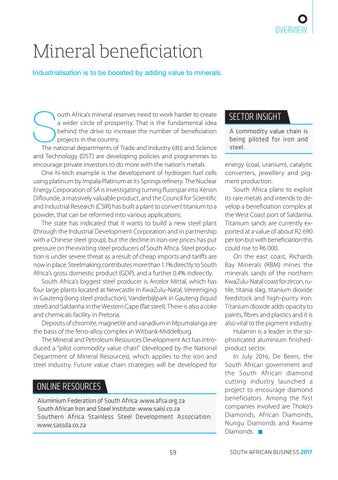OVERVIEW
Mineral beneficiation Industrialisation is to be boosted by adding value to minerals.
S
outh Africa's mineral reserves need to work harder to create a wider circle of prosperity. That is the fundamental idea behind the drive to increase the number of beneficiation projects in the country. The national departments of Trade and Industry (dti) and Science and Technology (DST) are developing policies and programmes to encourage private investors to do more with the nation's metals. One hi-tech example is the development of hydrogen fuel cells using platinum by Impala Platinum at its Springs refinery. The Nuclear Energy Corporation of SA is investigating turning fluorspar into Xenon Diflouride, a massively valuable product, and the Council for Scientific and Industrial Research (CSIR) has built a plant to convert titanium to a powder, that can be reformed into various applications. The state has indicated that it wants to build a new steel plant (through the Industrial Development Corporation and in partnership with a Chinese steel group), but the decline in iron-ore prices has put pressure on the existing steel producers of South Africa. Steel production is under severe threat as a result of cheap imports and tariffs are now in place. Steelmaking contributes more than 1.1% directly to South Africa’s gross domestic product (GDP), and a further 0.4% indirectly. South Africa’s biggest steel producer is Arcelor Mittal, which has four large plants located at Newcastle in KwaZulu-Natal, Vereeniging in Gauteng (long steel production), Vanderbijlpark in Gauteng (liquid steel) and Saldanha in the Western Cape (flat steel). There is also a coke and chemicals facility in Pretoria. Deposits of chromite, magnetite and vanadium in Mpumalanga are the basis of the ferro-alloy complex in Witbank-Middelburg. The Mineral and Petroleum Resources Development Act has introduced a "pilot commodity value chain" (developed by the National Department of Mineral Resources), which applies to the iron and steel industry. Future value chain strategies will be developed for
ONLINE RESOURCES Aluminium Federation of South Africa: www.afsa.org.za South African Iron and Steel Institute: www.saisi.co.za Southern Africa Stainless Steel Development Association: www.sassda.co.za
59
SECTOR INSIGHT A commodity value chain is being piloted for iron and steel. energy (coal, uranium), catalytic converters, jewellery and pigment production. South Africa plans to exploit its rare metals and intends to develop a beneficiation complex at the West Coast port of Saldanha. Titanium sands are currently exported at a value of about R2 690 per ton but with beneficiation this could rise to R6 000. On the east coast, Richards Bay Minerals (RBM) mines the minerals sands of the northern KwaZulu-Natal coast for zircon, rutile, titania slag, titanium dioxide feedstock and high-purity iron. Titanium dioxide adds opacity to paints, fibres and plastics and it is also vital to the pigment industry. Hulamin is a leader in the sophisticated aluminium finishedproduct sector. In July 2016, De Beers, the South African government and the South African diamond cutting industry launched a project to encourage diamond beneficiators. Among the first companies involved are Thoko’s Diamonds, African Diamonds, Nungu Diamonds and Kwame Diamonds. SOUTH AFRICAN BUSINESS 2017
